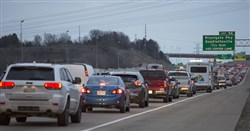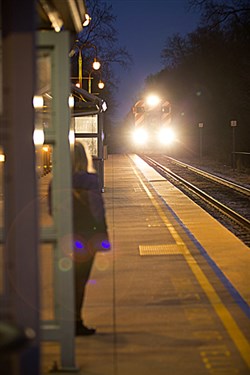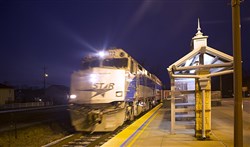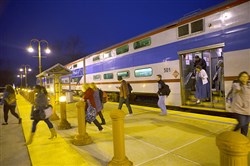VOL. 41 | NO. 3 | Friday, January 20, 2017
Is Legislature finally ready to fund transportation projects?
By Hollie Deese
Angie Graves has always been a resident of Portland in Sumner County, pretty much on the same property. She is currently living in the same home her father once rented when she was a child.
When she isn’t home she’s in her car for hours a day, moving between housecleaning jobs across the Midstate.
Her boss tries to keep her daily assignments close together, but with so many time constraints – client availability, gated-community coordination and her own availability – some days find her going from Sumner to Williamson to Wilson counties and back again.
She dreads having to exit Murphy or Hillsboro Roads off 440 on Nashville’s west side and has cultivated a collection of shortcuts to avoid the traffic that seems to go hand in hand with those ramps.
“If our first house is at 9 o’clock in Franklin, we will meet in Hendersonville at 7:45 and fight traffic to get there,” Graves says of her crew. “Then our next house is at noon in Mount Juliet, and we fight our way back. Then from there our next house is at Gallatin. You have to travel forever to get across from Mount Juliet to Rivergate or vice versa.”
Robertson County Mayor Howard Bradley is part of the Middle Tennessee Mayor’s Caucus, a regional partnership of more than 40 mayors and county executives that endorse state action on transportation funding as well as looking for other funding solutions.
He joins county officials and commuters throughout Middle Tennessee hoping this legislative session is finally the one in which a dedicated funding source will be set to finance Middle Tennessee road and transportation projects.
Of particular interest for the region as a whole is the Nashville MTA/RTA’s 25-year, $6 billion comprehensive transportation plan, nMotion.
That plan examines how the transit system works today and identifies ways to enhance service and attract and retain new riders while meeting the growing needs of Middle Tennessee.
The plan’s major points include:
– Longer bus hours
– Extensions of the Music City Star rail line
– Downtown bus route changes
– Direct service to Nashville International Airport
– Regional light rail service
“By the year 2040, Middle Tennessee’s population is expected to grow by 1.3 million people, and the amount of time residents spend in their cars is expected to double. “That becomes both a productivity and quality of life issue for Middle Tennessee employers,” says Alexis Poe, spokeswoman for the Nashville Area Chamber of Commerce-backed coalition Moving Forward, which supports nMotion and legislation that gives local communities the option to raise revenue dedicated to specific projects at the ballot box.
The Moving Forward scorecard was expected to be released by the Nashville Area MPO Executive Board meeting earlier this week. That scorecard outlines the progress that has been made in recent years along with some of the challenges in achieving multi-modal transportation options for Middle Tennessee.
“The scorecard will serve as a current snapshot of what has been achieved, and what has yet to be accomplished,” Poe adds.
Some of those initial goals include:
– Completion of an RTA/MTA strategic plan within one year
– Identification and passage of state and federal government revenue enhancements for transit within two years
– Identifying and securing a local dedicated funding source for transit in the region within three years
Last summer, Moving Forward released its first report, which included key recommendations to achieve multi-modal transportation options in Middle Tennessee and highlighted the work and focus of each task force.
In the fall, Moving Forward released a revenue study that resulted from efforts to evaluate around 20 potential local revenue sources. From that, seven merited further study. That work will be happening in the coming months, Poe says.
But without funding, any plan at all is a non-starter. But doing nothing isn’t an option. Not anymore.
Regional transit puzzle
Bradley says the situation in his county is a bit different in that 70 percent of his residents commute out of county to work each day.
“That creates enormous stress, unhealthy situations, expense,” he explains. “Especially those that are commuting into downtown, they are spending a minimum of two hours a day in the car, and that’s just wrong on so many levels.
“That’s why I’m glad that we’re approaching this problem as a region, because people who are commuting in from Murfreesboro and Franklin are facing similar, if not worse, situations.
“We’ve got to look multi-modal,” he adds. “We’ve got to do more things to encourage people to carpool. Then, as far as my county’s concerned and Sumner County is concerned, we’ve got to have frequently-running buses that go from Gallatin downtown and Springfield downtown.
“We currently have two buses in the morning and two returning in the evening from Springfield, but you’re stuck downtown all day long. We’ve got to find a better way to get people downtown so they can get back and forth.”
Making public transit appealing
The Regional Transit Authority currently operates nine regional bus routes between downtown Nashville and Brentwood, Clarksville, Franklin, Gallatin, Hendersonville, Joelton, La Vergne, Murfreesboro, Smyrna, Springfield, Spring Hill and Thompson’s Station, in addition to the 46 routes provided in Davidson County and the rideshare program that organizes vanpools and carpools.
Demand is only growing, says Clarksville Mayor Kim McMillan, vice chair of the Mayor’s Caucus as well as the chair of the RTA.
She points out the commuter bus service that the RTA currently operates from Clarksville to Nashville is so popular they run up to four buses, four times a day, back and forth between the two cities making a stop in Cheatham County. The monthly average of passengers of that ride is approaching 6,000-7,000.
Keeping those passengers content to ride is a crucial component.
“In order for people to be able to ride the commuter bus services that we have, it has to be convenient for them,” McMillan points out.

Anyone living north of downtown knows what a nightmare it is getting home in the afternoons. And why is that Metro bus stuck in traffic? A dedicated lane would fix that problem.
-- Michelle Morrow | The LedgerThat means looking to add additional route times to satisfy a number of work schedules, as well as adding more buses. It also means coordinating growth with the MTA so people arriving downtown have easy and affordable opportunities to connect to another bus.
“We’re looking at being able to do that all across the region,” McMillan says.
An 18-member transportation committee was officially announced by both legislative houses last week and includes representatives from across the state, including mass transit advocate Jeff Yarbro, who sponsored a bill that would allow buses to use road shoulders during high congestion times.
The legislature recently passed that piece of legislation that the Mayor’s Caucus had been advocating, to allow the Tennessee Department of Transportation to explore the concept of buses using the shoulder on the interstate.
“If you’re in a bus and you’re in the same traffic jam that everybody else is … then it’s not going to benefit you to ride the bus,” McMillan says. “We have to have some reason why the bus can get there quicker than you could if you were in a car.
“Bus on a shoulder is a wonderful alternative. The legislation has passed, and we are now in the stages of TDOT trying to explore what would have to happen to prepare our shoulders on the interstate to actually carry that traffic.”
Because Middle Tennessee is a regional economy, McMillan says it is imperative to efficiently transport citizens in order for them to work and find jobs. And that means making sure riding the bus remains an appealing option over sitting in traffic.
“A lot of people in Clarksville work in Nashville, as do a lot of other counties outside the city,” she says.
“Now, with the growth of jobs in places like Clarksville – we have Hankook Tire with 1,800 new employees. Google is there – we have all of these companies and people from other places coming into Clarksville, and we have to get them around. The interstates and cars are not always the way to do it.”
Bradley says he remembers when there was rail service from Springfield to Nashville. He’d like to see that service return to Robertson County again, even if it isn’t steel on rails but rather rubber on road.
“It was great just to be able to hop the train here in town, run around downtown, do your shopping, and then get back to Union Station and get on the train,” he recalls. “Those trains ran all day long. We’ve got to be doing that with buses.”

A Music City Star passenger waits on the commuter train at the Hermitage Station headed for downtown Nashville on a recent Friday night.
-- Michelle Morrow | The Ledger“I’m a great advocate of our Relax & Ride buses,” Bradley continues. “They are great. They’re clean; they’re efficient. You can grab a cup of coffee and the newspaper, and by the time you’re finished you are downtown. I think once we get people on the buses, they’ll come back to them, but we’ve got to have more buses that run more frequently.”
Graves says she would gladly use public transportation if she could rely on it actually getting her to work when needed. She needs a bus that picks up in White House, Hendersonville or Goodlettsville, all meeting points for her cleaning crew.
“As a single mom of two, my day depends on point A to point B on time,” she explains.
Increasing rail service
The RTA also oversees the Music City Star regional rail, the first segment of which connects Davidson and Wilson counties using a 32-mile section of track belonging to the Nashville & Eastern Railroad Authority. Tracks, signals and bridges were upgraded and replaced and various grade crossings were improved.
There are six stations: Riverfront, Donelson, Hermitage, Mt. Juliet, Martha and Lebanon. Three trains provide weekday morning and evening service.
Over the past 10 years, transit ridership in the region has increased by about 25 percent, says Amanda Clelland, marketing and communications specialist with the Nashville MTA and RTA. Though 2016 saw a small decline in ridership, primarily due to lower fuel prices, she says, ridership continued to increase on the Music City Star, in the StrIDe student pass program and in the AccessRide program for senior citizens and persons with disabilities.
“The projects MTA and RTA are focused on in 2017 will be incremental, as laid out in the nMotion plan,” she explains. “A big focus will be on replacing the existing fare collection system with a new system that will make fare payment simpler, including allowing for the use of payment by mobile phone and smart card.”
MTA will also continue expansion of the passenger waiting shelter program, in which the agency expects to more than double the number of shelters over a three-year period.
Clelland adds MTA/RTA will be partnering with Metro Public Works to initiate a major upgrade in the Murfreesboro Pike Corridor, including pedestrian improvements at more than 40 intersections, advanced traffic signal technology that includes signal priority for mass transit vehicles, and “queue jumps” at four locations to help improve transit service reliability.
In 2017, there will be a new Music City Star station at the Hamilton Springs Development in Lebanon, and MTA has been working with private developers and the city of Mt. Juliet to advance transit-oriented development at that station. They are beginning the same process at Donelson Station.
MTA/RTA will continue advancement in the coming months of long-term projects outlined in nMotion with a high-capacity corridor study in the five corridors identified for full Bus Rapid Transit or Light Rail (Gallatin Road, Dickerson Pike, Murfreesboro Pike, Nolensville Pike and Charlotte Pike).
MTA/RTA also is partnering with the Nashville Area Metropolitan Planning Organization on a full-blown alternatives analysis for the South Corridor, parallel to I-65 between Williamson and Davidson Counties.

The Music City Star leaves the Hermitage Station headed for downtown Nashville.
-- Michelle Morrow | The LedgerMTA did a complete overhaul of service on the Nolensville corridor in Spring 2016 that included the introduction of ‘BRT lite’ service with 10-minute peak frequencies and night and weekend service on a re-engineered Edmondson-Grassmere route.
“We’ve been monitoring and re-timing nearly every route to improve on-time performance for the most customers possible,” Clelland adds. “We’ve also re-routed buses in the downtown corridor.”
Other recent enhancements include improved Saturday frequency to Opry Mills and new Saturday service on Lebanon Pike.
Upcoming changes this spring include ‘BRT lite’ service on Sundays in Gallatin, better evening frequencies to North Nashville via the #22 Bordeaux, and a cross-town connection on Thompson Lane between Murfreesboro Pike and 100 Oaks.
“Our corridor doesn’t have any trains, but we hope that it will,” McMillan says of the Northwest Corridor.
“One thing Clarksville’s famous for is that Monkees’ song, “The Last Train to Clarksville.” And the one thing that I want to see done before I’m no longer mayor is to get that last train to Clarksville.”
‘Previous dollars’
The nMotion report cites conversations with engineers from Parsons Brinckerhoff Engineering Services showing projected ridership between Nashville and Clarksville below what would generally qualify for federal funding.
However, ridership would increase greatly should that line go through downtown.
“There is an existing freight line in some places, but it would have to be rehabbed extensively in order to operate as a commuter line,” McMillan says. “But, we have to look at ways to deal with that because I-24 going between these two cities is two lanes.
“It’s not going be able to handle the amount of traffic.”
Traffic is greatly increasing within Clarksville, too, causing stress for drivers in one of the fastest-growing cities in the region, even among those who don’t even commute to Nashville.
“Our population is exploding,” McMillan says. “Our population is growing faster than almost any other population in the state and in Middle Tennessee. Just in the last 10 years, in the city limits, we grew by over 10 percent. It’s just unbelievable.”
In the 2010 census Clarksville’s population in the city limits was 132,000. McMillan says today it has topped 150,000.
“We’re building roads every time we turn around,” she explains. “We’re fighting in Clarksville just like all the other communities for those precious dollars from TDOT to continue to expand our roads.
“We’re building more and more city-owned roads with our own dollars, but we have to work with the state to try to get those roads developed and expanded. Most of our roads in Clarksville are state roads, so we have to fight like everybody else.”
Gas tax increase possible

Music City Star commuters exit the train at the Hermitage Station on a recent Friday night.
-- Michelle Morrow | The LedgerTennessee’s gas tax, 21.4 cents per gallon, last changed in 1989. From that 21.4 cents, 7.9 cents goes to local governments, 12.8 to the Tennessee Department of Transportation and the remainder to the state’s general fund. The federal gas tax that funds the U.S. Department of Transportation Highway Trust Fund is 18.4 cents and hasn’t been increased since 1993.
This generates about $700 million in revenue a year to pay for the state’s transportation infrastructure. That budget goes to fund basic operating costs, highway maintenance and resurfacing in addition to new construction, right-of-way purchases, engineering services and bridges.
While the state population increased 14 percent between 2000 and 2013, the gas tax remained flat, largely due to increased fuel efficiency. So despite consumer concerns of a raised tax, many transit organizations have their fingers crossed that this will be the year it actually happens as a way to tackle the $6 billion backlog of road and bridge construction projects currently plaguing the state.
And since Haslam has not addressed his much-anticipated gas tax and transportation funding proposal yet, hopes are high he will do so at his State of the State address on Jan. 30.
“We know the governor has a plan,” Bradley says. “We really expected that to be announced a couple of months ago; but, surely now in the very near future we’re going to know what the specifics are.”
McMillan concurs. “Obviously, we’re all watching very closely the governor’s proposal that’s going to be introduced in the legislature to deal with whether or not you should raise the gas tax.’’
“There are necessary and needed roadway projects that TDOT just can’t get to. There’s a lot in Clarksville.”
Dedicated funding stream
Jason Spain, executive director of the Tennessee Public Transportation Association, has 26 transit agency members across the 95 counties statewide. Members include a wide variety of interested parties from the National Transit Alliance to the development district that covers multi-county rural areas.
Spain says the gas tax is really only part of a bigger conversation about money.
“It’s critically important to increase funding for our transportation infrastructure regardless of how you do that,” Spain points out. “I don’t know how you get from here to there without using a gas tax. And I think, frankly, a lot of people think that’s the best way to go about it because you pay it when you use the roads. So that makes a lot of sense.
“But in the overall picture you just can’t continue taking care of the system we have, much less make very-needed improvements, without increasing the amount of resources available.”
Spain, a Nashville native, says community participation on resolving traffic and transit issues is welcome through a new grassroots initiative, the Tennessee Transit Coalition. But making any viable transit plan work requires a dedicated funding stream – the option for local communities to establish their own, and for additional state funds to assist areas where that isn’t really an option.
“The initial task is a petition to Gov. Haslam to include a meaningful public transportation component in his proposal to the General Assembly,” Spain adds. “I met with the Governor’s staff earlier this week and delivered the first 1,000 or so petitions from over 60 counties across the state. We are very much trying to engage people in this conversation, and using a method to reach out to their elected officials to help us move this forward.”
Spain says public transit is an issue of mobility and a necessity for many, including the elderly, people with disabilities, people who don’t have access to their own transportation – having an option allows them to remain independent. It’s also a growing choice for people who would rather do something else with their time than sit in traffic and find parking.
“Whether you use it or not, you benefit from it because it’s taking cars off the road, it’s giving people a means to get to jobs and doctor’s appointments and schools and contribute to society and remain independent,” Spain adds. “I think there’s a growing awareness and a growing demand, and we’re hoping to be able to help meet it.”
Bradley says he is looking forward for the opportunity to have a local-option sales tax referendum so individual communities like his in Robertson County can decide if they want to be part of a regional transportation plan.
“I’m excited about that,” he adds. “I think the people that are stuck in traffic two hours a day would be eager to see a half penny on every dollar they spend dedicated toward transit.”
Traffic increasing everywhere
Drive times limit the amount of homes Graves can clean in a day, which limits her income. It’s not likely to get easier just yet. Davidson County’s population is projected to grow to 714,756 by 2020, topping 1 million by 2052.
McMillan says getting congestion in check would boost the local and regional economy.
“When you look at the charts and the statistics you see that the way we commute now among the region is phenomenal,” McMillan says. “You’ve got to make it accessible for people to get to those jobs.
“If people don’t have a job, they can’t make a wage to be able to feed their families and make our state productive. That’ why regional transit solutions are really the key to our whole economic system in Middle Tennessee.”
McMillan looks at Clarksville’s growth as a good problem to have even as they try and deal with the issues that come with it.
“People like living in Clarksville or they wouldn’t continue to locate and live there, and our population wouldn’t keep growing.’’
And while growth is a good issue to have, it is still an issue.
“This is a problem we’ve got to solve,” Bradley says. “We can’t put this off to the next generation. All the great things that are happening in and around Nashville right now are contingent upon being able to get to them.
“I feel like that we are at a historic crossroads in terms of being able to make a decision as a region as to how to go forward.”
Bradley cites the Nashville Area Metropolitan Planning Organization State of Transportation in Middle Tennessee 2015 Annual Report that that says within 25 years the commute from to Springfield to Nashville could double in time. The numbers were similar for Gallatin and many other cities.
“That makes it really unviable for you to live in Robertson County and work in Nashville,” Bradley says.
“I think we’ve got a choice between five years of congestion or 25 years of gridlock, and nobody wants the latter,” he adds.
“We’ve got a chance to, as a region, step up and do the right thing without having a lot of strong political forces against us. This is a historic opportunity, and if we miss it this year, it may be a long time before it comes back around again.”
But Spain hopes all of the state’s urban issues don’t overshadow the rural ones in the process.
“I think in a lot of cases people see rural public transit vehicles without knowing that’s what they are,” Spain says.
“We have eight resource agencies and one development district that provide service in our rural countries.
“And I think people can rely on them to take their elderly parents, or a sick nephew, or what have you to a doctor’s appointment, or get them where they need to go without realizing that that’s public transportation.”
Another aspect that Graves thinks people need to consider when it comes to connecting the rural and urban areas is how important repaving potholes is to the safety and well-being of injured and sick in the back of an emergency vehicle.
She recently experienced this need firsthand after her daughter was in a golf cart accident and was transported from the Portland ER to Vanderbilt via ambulance.
“I know sometimes in the back of an ambulance you’re trying to start IVs and trying to save a life,” she says. “My dad was a volunteer fire fighter, so this means a lot to me.
“I think if we can keep our roads with less potholes, we might actually be able to save more lives.
“You can’t have steady hands in the back of an ambulance going 70 miles an hour on our road systems.”